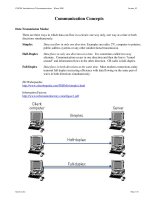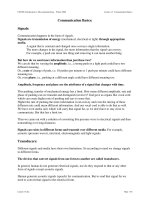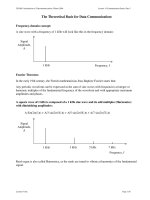Tài liệu lecture 2: Communication Concepts ppt
Bạn đang xem bản rút gọn của tài liệu. Xem và tải ngay bản đầy đủ của tài liệu tại đây (109.37 KB, 3 trang )
CSN200 Introduction to Telecommunications, Winter 2000 Lecture_02
Communication Concepts
Data Transmission Modes:
There are three ways in which data can flow in a circuit: one way only, one way at a time or both
directions simultaneously.
Simplex Data can flow in only one direction. Examples are radio, TV, computer to printers,
public address systems or any other unidirectional transmission.
Half-Duplex Data flows in only one direction at a time. It is sometimes called two-way
alternate. Communication occurs in one direction and then the line is “turned
around” and information flows in the other direction. CB radio is half-duplex.
Full Duplex Data flows in both directions at the same time. Most modem connections today
transmit full duplex increasing efficiency with data flowing on the same pair of
wires in both directions simultaneously.
ZD Webopaedia:
/>
Information Factory:
/>
lecture 2.doc Page 1 (3)
CSN200 Introduction to Telecommunications, Fall 1999 Lecture_02
Parallel vs. Serial Transmission:
Parallel:
In parallel transmission all bits in a single character are transmitted simultaneously.
Data travels in parallel (simultaneously) within a PC over the data bus (bundle of data lines).
Similarly we can transmit data between two PCs in parallel.
That is all data lines (normally 8) from one PC are connected to the other PC.
Parallel transmission is primarily limited to transmission of data within a computer, between
computers and between a computer and a printer.
It is fast compared to serial transmission but limited to shorter distances.
It sends data bits in parallel (typically 8 bits at a time) using separate wires or circuits for
each bit. This “byte-wide” transmission is faster than serial transmission but requires more
wires in the cable and can not be used over long distances. It is not used very often in data
communications but is used extensively for computer busses and for printer connections.
Serial:
In serial transmission bits are transmitted in a linear fashion, one after the other.
It is slower but can travel longer distances and is widely used.
It is the predominant method of transferring information in data communications. Data bits
are sent serially or sequentially bit-by-bit over a single wire or communications circuit.
Sending bits one after another is slower than sending them in parallel but most long-distance
circuits only allow serial transmission. It is the mode of communication used on a PC’s
serial port as well as on local area networks.
lecture 2.doc Page 2 (3)
CSN200 Introduction to Telecommunications, Fall 1999 Lecture_02
Point-to-point vs. Multidrop: (p. 80)
Point-to-point:
• A term used to describe a data channel which connects two, and only two, terminals.
• Point-to-point Circuit: A communication circuit, or system connecting two points through
a telephone circuit, or line.
• Point-to-point Network: A Point-to-point Network is one in which exactly two stations
are connected. It may be dial connection or a leased line.
• Costly and faster.
Multidrop: (or Multipoint)
• Describes a telephone line configuration in which a single transmission facility is shared
by several end stations.
• Also called shared circuit.
• Multidrop line: Line or circuit interconnecting several stations. Also called multipoint
line.
• Only one station can send or receive at any time, all others must wait.
• Cheaper and slower.
lecture 2.doc Page 3 (3)









